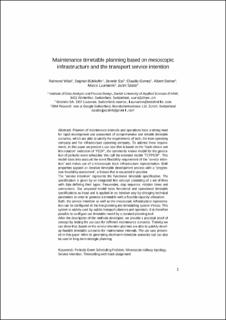Please use this identifier to cite or link to this item:
https://doi.org/10.21256/zhaw-18548Full metadata record
| DC Field | Value | Language |
|---|---|---|
| dc.contributor.author | Wüst, Raimond Matthias | - |
| dc.contributor.author | Bütikofer, Stephan | - |
| dc.contributor.author | Ess, Severin | - |
| dc.contributor.author | Gomez, Claudio | - |
| dc.contributor.author | Steiner, Albert | - |
| dc.contributor.author | Laumanns, Marco | - |
| dc.contributor.author | Szabo, Jacint | - |
| dc.date.accessioned | 2019-10-23T13:54:01Z | - |
| dc.date.available | 2019-10-23T13:54:01Z | - |
| dc.date.issued | 2019-09-24 | - |
| dc.identifier.issn | 2210-9706 | de_CH |
| dc.identifier.uri | https://digitalcollection.zhaw.ch/handle/11475/18548 | - |
| dc.description.abstract | Planners of maintenance intervals and operations have a strong need for rapid development and assessment of comprehensive and reliable timetable scenarios, which are able to satisfy the requirements of both, the train operating company and the infrastructure operating company. To address these requirements, in this paper we present a use case that is based on the ‘track-choice and line-rotation’ extension of ‘PESP’, the commonly known model for the generation of periodic event schedules. We call the extended model ‘TCFPESP’. This model takes into account the event flexibility requirement of the ‘service intention’ and makes use of a mesoscopic track infrastructure representation. Both properties support an iterative timetable development process with a ‘progressive feasibility assessment’, a feature that is requested in practice. The ‘service intention’ represents the functional timetable specification. The specification is given by an integrated line concept consisting of a set of lines with data defining their types, frequencies, stop sequence, rotation times and connections. Our proposed model takes functional and operational timetable specifications as input and is applied in an iterative way by changing technical parameters in order to generate a timetable with a feasible capacity allocation. Both, the service intention as well as the mesoscopic infrastructure representation can be configured in the line planning and timetabling system Viriato. This system is widely used by public transport planners and operators. It is therefore possible to configure our timetable model by a standard planning tool. After the description of the methods developed, we provide a practical proof of concept by testing the use case for different maintenance scenarios. Thereby we can show that, based on the service intention planners are able to quickly develop feasible timetable scenarios for maintenance intervals. The use case presented in this paper refers to generating short-term timetable scenarios but can also be used in long-term strategic planning. | de_CH |
| dc.language.iso | en | de_CH |
| dc.publisher | Elsevier | de_CH |
| dc.relation.ispartof | Journal of Rail Transport Planning & Management | de_CH |
| dc.rights | https://creativecommons.org/licenses/by-nc-nd/4.0/ | de_CH |
| dc.subject | Periodic event scheduling problem | de_CH |
| dc.subject | Mesoscopic railway topology | de_CH |
| dc.subject | Service intention | de_CH |
| dc.subject | Timetabling with track assignment | de_CH |
| dc.subject.ddc | 380: Verkehr | de_CH |
| dc.title | Maintenance timetable planning based on mesoscopic infrastructure and the transport service intention | de_CH |
| dc.type | Beitrag in wissenschaftlicher Zeitschrift | de_CH |
| dcterms.type | Text | de_CH |
| zhaw.departement | School of Engineering | de_CH |
| zhaw.organisationalunit | Institut für Datenanalyse und Prozessdesign (IDP) | de_CH |
| dc.identifier.doi | 10.1016/j.jrtpm.2019.100146 | de_CH |
| dc.identifier.doi | 10.21256/zhaw-18548 | - |
| zhaw.funding.eu | No | de_CH |
| zhaw.originated.zhaw | Yes | de_CH |
| zhaw.pages.start | 100146 | de_CH |
| zhaw.publication.status | acceptedVersion | de_CH |
| zhaw.volume | 11 | de_CH |
| zhaw.embargo.end | 2021-09-24 | de_CH |
| zhaw.publication.review | Peer review (Publikation) | de_CH |
| zhaw.webfeed | Simulation and Optimization | de_CH |
| zhaw.webfeed | Digital Mobility | de_CH |
| zhaw.author.additional | Yes | de_CH |
| Appears in collections: | Publikationen School of Engineering | |
Files in This Item:
| File | Description | Size | Format | |
|---|---|---|---|---|
| JRTPM_SecRev_Final.pdf | Accepted Version | 1.05 MB | Adobe PDF |  View/Open |
Show simple item record
Wüst, R. M., Bütikofer, S., Ess, S., Gomez, C., Steiner, A., Laumanns, M., & Szabo, J. (2019). Maintenance timetable planning based on mesoscopic infrastructure and the transport service intention. Journal of Rail Transport Planning & Management, 11, 100146. https://doi.org/10.1016/j.jrtpm.2019.100146
Wüst, R.M. et al. (2019) ‘Maintenance timetable planning based on mesoscopic infrastructure and the transport service intention’, Journal of Rail Transport Planning & Management, 11, p. 100146. Available at: https://doi.org/10.1016/j.jrtpm.2019.100146.
R. M. Wüst et al., “Maintenance timetable planning based on mesoscopic infrastructure and the transport service intention,” Journal of Rail Transport Planning & Management, vol. 11, p. 100146, Sep. 2019, doi: 10.1016/j.jrtpm.2019.100146.
WÜST, Raimond Matthias, Stephan BÜTIKOFER, Severin ESS, Claudio GOMEZ, Albert STEINER, Marco LAUMANNS und Jacint SZABO, 2019. Maintenance timetable planning based on mesoscopic infrastructure and the transport service intention. Journal of Rail Transport Planning & Management. 24 September 2019. Bd. 11, S. 100146. DOI 10.1016/j.jrtpm.2019.100146
Wüst, Raimond Matthias, Stephan Bütikofer, Severin Ess, Claudio Gomez, Albert Steiner, Marco Laumanns, and Jacint Szabo. 2019. “Maintenance Timetable Planning Based on Mesoscopic Infrastructure and the Transport Service Intention.” Journal of Rail Transport Planning & Management 11 (September): 100146. https://doi.org/10.1016/j.jrtpm.2019.100146.
Wüst, Raimond Matthias, et al. “Maintenance Timetable Planning Based on Mesoscopic Infrastructure and the Transport Service Intention.” Journal of Rail Transport Planning & Management, vol. 11, Sept. 2019, p. 100146, https://doi.org/10.1016/j.jrtpm.2019.100146.
Items in DSpace are protected by copyright, with all rights reserved, unless otherwise indicated.